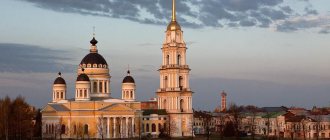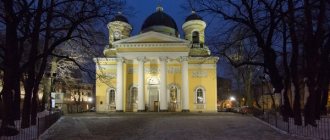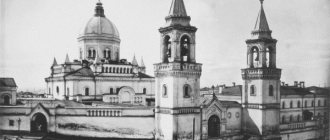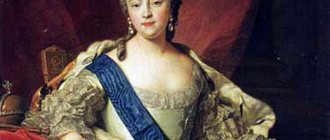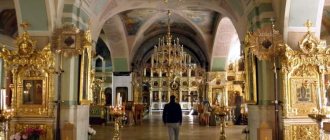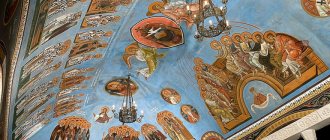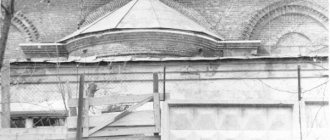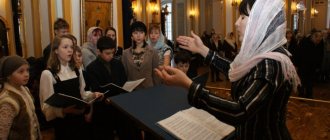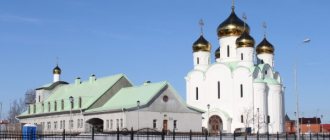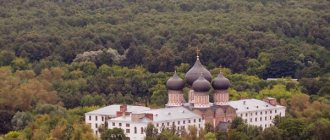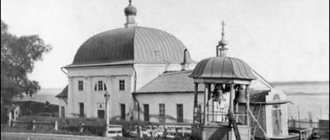On the high picturesque bank of the river. Yauza, near one of the Poklonnaya Mountains, is the Andronikov Monastery (Savior-Andronikov, Svyato-Andronikov, Andronikov of the Savior Not Made by Hands). The monastery is one of the main shrines of the capital and is considered one of the oldest buildings in the city. According to some sources, this building is 50-60 years older than the Kremlin. Already in past centuries, the monastery delighted people with its architectural ensemble. Above the territory of this majestic structure, like a guest from the past, inspiring residents for centuries with its elegant architectural forms, rises the Spassky Cathedral of the Spaso-Andronikov Monastery. The cathedral is called the most ancient Moscow temple.
Where is the Spassky Cathedral of the Andronikov Monastery
The Andronikov Monastery of the Savior Not Made by Hands was founded, according to studies of the biographies of holy people, by Metropolitan Alexy as a metropolitan residence. The Metropolitan assigned Andronik, a disciple of the wonderworker Sergius of Radonezh, to be involved in the organization of the monastery. The Abode of the All-Merciful Savior historically inherited his name.
The original wooden cathedral and monastery walls were supposedly built between 1357 and 1361. The buildings were erected on the Grand Duke's land 7 versts east of the Kremlin walls, near the mouth of the Yauza. Nowadays, the architectural ensemble of the monastery is geographically included in the Central Administrative District of the capital's metropolis.
The monastery complex is listed as building No. 10 on Andronevskaya Square. Within the walls of the historical building there is a Museum named after the famous icon painter Andrei Rublev, the collection of which contains priceless objects of ancient Russian painting. Divine services are held in the existing Cathedral of the Image of the Savior Not Made by Hands.
In 1354, Metropolitan Alexy began construction of the Savior-Andronicus Monastery
The storm has subsided. The ship safely landed on the Russian coast and already in Moscow, the Metropolitan turned to St. Sergius of Radonezh with a request to give him his disciple Andronik to create a monastery with the Church of the Savior Not Made by Hands.
These events took place in 1354. The Monk Andronik became the abbot of the monastery, and in 1360 the wooden Spasskaya Church was built.
The miraculous image of the Savior. Metropolitan Alexy prayed for salvation during the storm in front of this icon and gave his word that upon returning to his homeland, he would build a temple in Moscow
Over the years, the wooden walls of the church became dilapidated, and in 1420, under Metropolitan Photius, a decision was made to build a stone church.
Thus, at the end of the 1420s, the Spassky Cathedral, unique in its architecture, was erected.
In 1425, Andrei Rublev and his icon-painting team went to Moscow to paint the new Christmas tree church of the Spaso-Andronikov Monastery.
St. Andrey Rublev. It was he who painted the new white stone church of the Spaso-Andronikov Monastery
This was the last work of the great master. In 1430, the icon painter died and was buried within the walls of the Andronikos Monastery.
How to get there
It is convenient for travelers and pilgrims to start their journey to the monastery complex from the Moscow metro station “Ilyich Square”. From the railway platform to the monastery gates there are 890 m, which can be overcome in 10 minutes.
Route: turn left from the station, walk along Sergius of Radonezh Street to Andronevskaya Square, turn right on the square, walk along the path of the square past the monument to Rublev to the entrance of the monastery. You can make your journey easier and take one stop to the square on the 55th, 125th, 40th bus or 45th trolleybus.
Alternative route options start from the “Rimskaya” and “Marksistskaya” metro stations.
| Metro station | Distance | How to get there | Travel time |
| Ilyich Square | 890 m | On foot | 10 min |
| Roman | 1 km | On foot | 12 min |
| Marxist | 1.4 km | Bus 567 Stop – “Andronevskaya Square” | 3 stops – 5 min., then 330 m on foot – 4 min. The entire journey will take 9 minutes. |
Story
The Spassky Cathedral in wood was built upon the return of Metropolitan Alexei from a trip to Constantinople. The Metropolitan's ship was caught in a storm. Amid the confusion and panic, the priest maintained his fortitude, prayed earnestly and made a vow to the Savior to build a temple. He promised to dedicate the future prayer building to that holy holiday, on the day of which the travelers would safely reach the shore.
The Metropolitan did not break his word: he erected the Cathedral of the Image of the Savior Not Made by Hands in honor of the Feast of the Arrival. In the altar they placed the icon he had brought from his journey, showing the face of the Savior not made by hands on a board.
History has not preserved the exact date of construction of the stone cathedral.
Researchers of ancient architecture define the chronological framework of the building as the 20s of the 15th century.
Several editions of “The Tale of the Massacre of Mamayev” mention the construction of the Spassky Memorial Church in memory of the soldiers of the Battle of Kulikovo, buried on the territory of the monastery. The Spassky Cathedral of the Andronikov Monastery, according to other church sources, was erected in white stone under the third abbot of the monastery, the Monk Alexander.
Spassky Cathedral of the Andronikov Monastery before restoration
The cathedral walls were painted by famous painters, novices of the monastery, Andrei Rublev and Daniil Cherny. For their zealous desire for fasting and prayer, the Creator rewarded them with an unprecedented talent for sensually depicting the divine light with simple, material colors.
The cathedral was rebuilt more than once. The first renovation took place already in the middle of the 15th century: a vestibule topped with two domes was added to the western part of the temple. Over time, this structural element was removed.
At the end of the 17th century, a tented bell tower was added; at the end of the 18th century, it was dismantled. The cathedral was re-covered, the windows and doors were expanded. At the beginning of 1813, the temple, damaged by fire during the Napoleonic invasion, was repaired with a new domed top.
An amazing fact: in the building that was engulfed in fire, everything burned down except the reliquary with the relics of the first abbots of the monastery, who were canonized.
The holy building underwent a serious transformation in the late 40s of the 19th century. The construction of the temple according to the architectural design of P.A. Gerasimov was modernized by installing an octagonal hipped dome with an onion dome.
The tent covered the decorative cascade of the upper part of the temple, and deprived it of architectural originality. Two chapels were added to the main volume on the southern and northern sides, and a porch was installed under an iron roof with a decorative entrance.
The cathedral freed itself from the fashion trends of the 19th century in the mid-20th century. The reconstruction returned the building to its ancient, original appearance. The Museum of Ancient Russian Painting was opened on the territory of the monastery, and since 1989, divine services have resumed within the walls of the ancient prayer building.
Museum of Old Russian Culture
In 1960, the Central Museum of Ancient Russian Culture and Art named after. Andrey Rublev. The exhibition is located in the restored part of the Refectory and the Church of the Archangel Michael. It “chronologically” covers more than seven centuries of Russian artistic culture. The rector's building is dedicated to the exhibition hall.
The museum, founded in 1947, on the anniversary of the 800th anniversary of Moscow, over time became a repository and restoration center for dilapidated icons and frescoes collected here from destroyed churches in different regions of Russia. Now the museum's collection includes about 10,000 exhibits: icons from different eras, icon frames, ancient Orthodox religious attributes, rare handwritten and Old Believer printed church books and many other rarities.
The pride of the museum is the works of the circle masters Andrei Rublev and Dionysius, icons commissioned by Ivan the Terrible, and signed works by isographers from the Armory Chamber.
The museum hosts clubs for lovers of ancient Russian art for adults and children, lectures and excursions are held.
Architectural features of the temple
The ancient Cathedral of the Savior Not Made by Hands is a cross-domed church with one dome and 4 internal supports, an example of early Moscow architecture. The compositional peculiarity of the cathedral is expressed in the dynamic tension of the silhouette, the solemn aspiration of the entire structure upward.
The Spassky Cathedral of the Andronikov Monastery is made of rectangular limestone blocks with a polished front surface. White stone for construction was mined near the monastery, and the Kremlin buildings were built from the same limestone.
The main volume in the form of a small cube is installed on a high basement. In the upper part, the structure is decorated with a decorative cascade: one row of kokomars in the form of a semicircle with a point above the middle of the arc and two rows of kokoshniks. The light drum ends in a hemispherical dome topped with a cross.
On three sides, the temple structure is complemented by covered extensions with promising entrance portals. The ends of the portals and narrow windows have a lancet shape. White stone stairs leading to the portals emphasize the slender silhouette of the prayer building.
In the eastern part, three altar semicircular apses, covered with semi-domes, adjoin the base of the temple. The facades are divided by projecting pillars (pilasters), which coincide with the internal projections and interior arches.
Above the western entrance portal there is a round medallion with the image of the Savior Not Made by Hands. The picturesque painting was made during restoration using innovative phosphate paints that are resistant to the adverse influence of climatic conditions. The drawing reproduces the lost fresco “The Savior Not Made by Hands,” painted in the 15th century by Andrei Rublev.
The Spassky Cathedral, with its architectural individuality and perfection of lines, became an inspired model for architects of the 15th and 16th centuries. Craftsmen from all Russian lands visited the Andronikov Monastery to see the majestic temple, and then reproduce its architectural features in new church buildings.
A famous copy of the Spassky Cathedral is the Cathedral of the Nativity of the Virgin Mary (1505), located in the Nativity of the Virgin Mary Monastery in Moscow.
Interior decoration
4 main pillars divide the interior of the cathedral into 3 elongated rooms (nave). A cylindrical vault, supported by pillars, forms a cross under the dome at the intersection of the axial lines. The walls of the temple are decorated with vertical flat and narrow projections, which visually increase the height of the prayer room.
There are no princely choirs in the temple, concealing the space. 8 windows of the drum, window openings of the main volume and light slits of the central skylights create three registers of daylight sources, which promotes uniformity of lighting and brings a sense of transparency and rational organization to the interior.
The temple murals by famous painters Andrei Rublev and Daniil Cherny were almost completely cleaned off in the 18th century, and the cathedral was no longer decorated with frescoes. Small fragments of painted canvases by legendary painters have been preserved. Framed by the window of the church altar, one can see a floral ornament on a rich blue background, enclosed in interconnected circles of the same size.
In the 90s of the 20th century, during the restoration of the building, a heating and lighting system was designed, the interior of the temple was transformed: the elevation of the altar and the throne were redesigned. During the repair work, about a dozen white stone blocks decorated with carved decor were discovered.
There is an assumption that the altar barrier was made from relief, decorative stones in the original temple. Now samples of ancient stone decoration serve as exhibits of the monastery museum of ancient art.
The cathedral iconostasis underwent changes throughout the entire period of the temple's existence. At the end of the 18th century, icons were arranged in 4 tiers, the design had a lush, expensive decor.
Iconostasis before restoration
At the beginning of the next century, the altar partition in the classical style was distinguished by its exquisite severity and compositional dominance of the central fragment. In the mid-19th century, it was replaced by a luxurious gilded iconostasis with figured carved decor.
The modern wooden iconostasis is endowed with conciseness and simplicity. The walls of the cathedral are decorated with icons of a new type. There are not many of them. On one of the walls there is a unique image of the third abbot of the monastery, St. Alexander, under whom the stone Spassky Church was built. You will not see an icon with his image anywhere else.
Architectural ensemble of the cathedral
In 1947, the Spaso-Andronikov monastery received the status of a nature reserve, and the architectural ensemble included the surviving buildings:
- The white stone Cathedral of the Holy Image of the Savior Not Made by Hands of the Spaso-Andronikov Monastery, one of the oldest buildings in the city (restored in forms close to the original in 1959-1960). It is an example of ancient Russian architecture.
- Refectory chambers erected on the territory during the reign of Ivan III (1504-1506).
- Stone walls and towers built in the 17th – 18th centuries.
- Two-story building of the Rector's chambers (1690).
- Three-tiered Church, illuminated in the name of Archangel Michael. Initially, a two-tier refectory was built, with household services located on the first tier. Later, in the 90s of the 17th century, on the initiative of Queen Evdokia, construction of a church began near the refectory. The building was made in the Baroque style, but the architects managed to combine the style with the refectory, combining the two buildings with one cornice. However, due to the disgrace and exile of the queen, work was suspended, and only in 1739 the church was consecrated. The temple was restored in 1960; it houses the family tomb of the Lopukhins.
- The building of the fraternal building (1763). It was originally intended to house monks. Nowadays the museum depository is located here.
- Theological school building (1810-1814). Classes for church ministers were held here, and about 100 students were trained at the same time. Now used for museum departments.
According to experts, not a single temple building has such perfect proportions. The size of the monastery influenced other temple buildings; the whole composition looks very harmonious.
Temple shrines
The main shrine of the temple is the Image of the Savior Not Made by Hands. The revered 14th century icon was long considered a lost relic. In the last year of the 20th century, it was discovered in the storerooms of the Novodevichy Convent. In the iconostasis of the Cathedral of the All-Merciful Savior there is a copy of the holy image.
The temple shrine - the icon “Reverend Andronicus and Savva”, painted in the 19th century, has recently been rediscovered. An icon depicting the first abbots was discovered in the storage of the Church of the Resurrection on Arbat, and returned to the temple.
For many centuries, the cathedral housed a sacredly preserved relic - an ark with the relics of the first abbots of the holy monastery. During the revolutionary years, the heavy silver decoration of the ark was stolen , and the remains of the holy monks disappeared. However, there is hope that it is not without a trace.
During restoration and survey work, an ancient throne structure and 4 burials, located in pairs, were found under the cathedral altar. The appearing and disappearing fragrance when the burial was opened indicated that the discovered remains were the relics of holy people.
The monastic robes found date back to the beginning of the 15th century. An unconfirmed assumption is that the relics of the first four abbots of the monastery were discovered in the burial.
Further research into the fundamental basis of the altar yielded a new discovery. The burial of two monks was discovered. Scientists suggest that the remains of the famous icon painters Elders Daniel and Andrew have been found. The recovered relics of the six holy ascetics were transferred to newly created arks and displayed in the altar of the temple for worship.
Daily life of the temple
In addition to divine services, the clergy and the parish of the church are doing a lot of work to restore church values and spiritual traditions. The Orthodox community participated in the arrangement of a monastery in the Rostov region and the establishment of a monastery in the Rostov Epiphany monastery.
Parishioners helped in the search for the original location of the throne of the ancient Church of the Savior, as a result of which burials were discovered and shrines were discovered. The parish received approval and blessing from the highest clergy for subsequent survey work.
An icon painting workshop is organized at the cathedral - one of the best in the country. Talented painters in their works follow church canons, traditions and techniques of ancient Russian temple painting, and restore bit by bit the knowledge forgotten in Soviet times.
The most famous tradition of the monastery of the All-Merciful Savior - the Znamenny chant - has been renewed. A school of ancient Russian singing was organized at the cathedral, ancient music manuscripts were deciphered and published.
Pilgrimage plays a big role. Travel is organized to places sacred to the Orthodox faith for the purpose of prayer and worship. The church parish is working to republish ancient books, publish periodical Christian literature, and form a monastery library. The official website has been opened.
Singing school and icon painting workshop
Today, not only divine services are held on the territory of the temple. Under him, there is a school of Znamenny singing - this is the main and oldest type of ancient Russian church singing, which still exists today. That's great rarity. The cathedral also has its own choir, which came to listen to Rachmaninov.
With the blessing of Patriarch Alexy II, the famous tradition of the Spaso-Andronikov Monastery - Znamenny singing - was restored in the Spassky Church in 1990. And now all services are celebrated with the statutory monophonic (unison) znamenny chant.
The church has an icon painting workshop and active publishing activities. On the basis of the monastery, church books are printed, which tell about the history and traditions of the cathedral.
Opening hours and schedule of services
The Spassky Cathedral of the Andronikov Monastery is open from 11 a.m. to 6 p.m. daily. At 14:00 the temple closes for 45 minutes. The church holds holiday and Sunday services. The service time is specifically indicated in the schedule on the official website of the monastery.
The priests of the Spassky Cathedral conduct weekday services in the Proshcha chapel, located next to the monastery, on Sergius of Radonezh Street, in building 25. The chapel is open to parishioners and pilgrims from 8 a.m. to 7 p.m. Regular services are held at 8:00, 9:00, 17:30.
Interesting Facts
- From the beginning of its opening, the temple was filled with icons by local residents and generously brought gifts of sacred images.
- During wartime, a sniper school was opened in the temple for training Red Army soldiers and most of the icons became targets.
- The cross from the temple was torn off by a tank.
- The temple is attractive to young people. More than 150 children come to communion every Sunday.
- One of the parishioners preserved the Icon of St. Nicholas the Wonderworker of Myra. The girl, seeing the icons thrown away by the Bolsheviks, took the largest one at her own risk and took it home. It turned out to be the Icon of St. Nicholas. The parishioner kept it for 50 years and returned it back after the church resumed its activities.
- For parishioners, the film club holds sessions once a month to show church and Christian films.
Interesting facts about the Spassky Cathedral of the Andronikov Monastery
The Spassky Cathedral of the Andronikov Monastery is inextricably linked with the history of the country; many outstanding people have visited its walls. The temple and monastery were erected on a landmark territory - the meeting place of Russian regiments led by Grand Duke Vsevolod Yuryevich with the enemy army of the Mongol Khan Batu.
There is information that within the walls of the first wooden church, Grand Duke Dmitry Donskoy, before the battle on the Kulikovo Field (1380), prayed to the Savior for victory, and here he offered a grateful prayer to the Creator.
Fragments of carved white stone blocks found during the restoration of the Spassky Cathedral. Late XIV – early XV centuries.
In the mid-17th century, Archpriest Avvakum Petrov was kept in the monastery for three months, imprisoned for preaching the Old Believers and rejecting Nikon’s church reform.
Queen Evdokia Lopukhina, wife of Peter the Great, prayed here. Through the efforts of the last Russian queen, equal in birth to her husband, the Church of the Archangel Michael was erected above the refectory. In the lower tier there was a tomb for parents, close relatives of the royal person, and noble Moscow nobles.
Sergei Vasilyevich Rachmaninov came to the church for services to listen to the amazing znamenny singing of the church choir. Nowadays, the Andrei Rublev Museum of Ancient Russian Art operates within the walls of the monastery. Perhaps this is the best monument to the outstanding holy ascetic, the legendary Russian painter. All the icons he painted had miraculous powers.
The Andronikov Monastery with its marvelous Spassky Cathedral is a dear guest from past centuries, bringing divine light, age-old wisdom and the delightful aesthetics of ancient Russian art to our modern world.
Article design: Vladimir the Great
